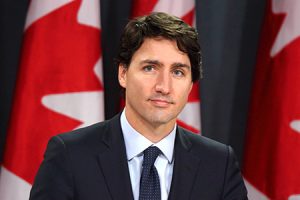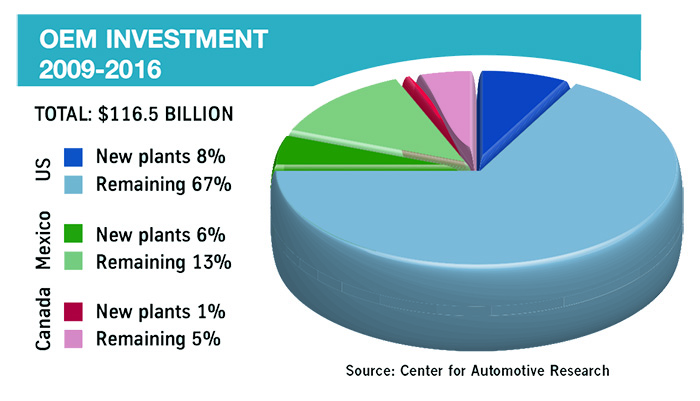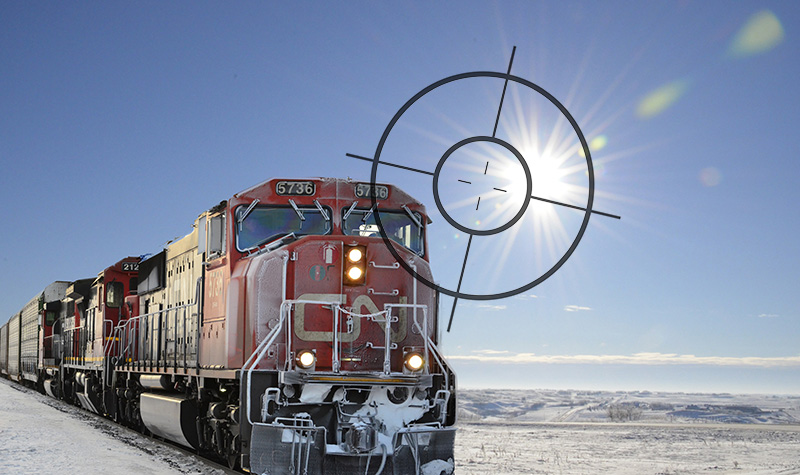The new US administration has left a bit of a cloud over Nafta, and while Canada may not be the primary target of any renegotiation, the country – and its important automotive supply chain – could still get caught in the crosshairs.
In this story...
Few understand the implications of this issue for Canada as well as Bradley, who for the past 20 years has been president and chief executive of the Canadian Trucking Alliance (CTA), which represents more than 4,500 trucking firms, owner-operators and suppliers across the country. For that reason, his cautious but confident optimism is reassuring.
After listening to the Trump administration’s rumblings over Nafta, talking to CTA members and trade experts, and watching coverage of Canadian prime minister Justin Trudeau’s meeting with Trump at the White House in February, Bradley points to potential silver linings on the clouds of uncertainty.

For one thing, Canada doesn’t appear to be the primary target of renegotiations, he says, citing Trump’s emphasis on “tweaking” the trade relationship with Canada – a significant contrast to the new president’s stark criticism of Mexican imports to the US. “While we can’t place too much emphasis on the first and a very short meeting, the tone and comments from the president [at the joint press conference] give us some solace that [Nafta] can and should be modernised,” Bradley says.
CTA members have raised concerns, however, and the protectionist rhetoric from Trump and many of his advisers is worrying for Canada’s automotive industry, which is closely tied to the US and is important for Canadian logistics providers. However, carriers have not reached a state of anxiety, Bradley insists.
“Truckers are pretty tough and competitive people – and the auto sector is not an easy sector to begin with,” says Bradley. “It’s very competitive and there’s a lot of pressure on suppliers across the supply chain, including the trucking industry. They will see what comes and they won’t panic unless there’s a need to do that.”
Perhaps such anxiety, especially the kind derived from endless speculation, just isn’t very Canadian. Bradley prefers to focus on the existing strength of US-Canada trade, especially the well established automotive supply chain between the two.
“It is perhaps the best example of integrated or synchronous manufacturing on the planet,” he says. Parts and components cross the border up to eight times before a vehicle is complete, with minimal customs controls and smooth crossing by truck and rail, especially between the province of Ontario – home to virtually all Canadian automotive manufacturing – and the US Midwest.
“It’s the Big Three [US-based carmakers] moving parts and vehicles across the border at will,” he says. Honda and Toyota also have important production bases in Canada that connect to US plants in Ohio and Indiana, as well as further south.
Statistics bear out the scale of this integration, including more balanced automotive trade flows between the US and Canada than the US and Mexico; Canada imported about $59 billion worth of US-made vehicles and parts in 2015, and it exports around $64.5 billion worth of vehicles and parts. By comparison, Mexico imported $22 billion in automotive goods from the US, while exporting $74 billion to it.
 "Just because you locate a facility in a certain country doesn’t mean that the supply chain is there to feed it. [It requires] years of development of the second tier and third tier supplier as well as the pipeline of work skills that you need to keep that supply chain healthy." - Jay Baron, Center for Automotive Research
"Just because you locate a facility in a certain country doesn’t mean that the supply chain is there to feed it. [It requires] years of development of the second tier and third tier supplier as well as the pipeline of work skills that you need to keep that supply chain healthy." - Jay Baron, Center for Automotive Research
Movements of automotive material are significant across multiple transport modes, including Canada’s class one railways that connect to the US. CTA statistics also point to significant volumes on the road: vehicles, automotive parts and transport freight accounted for 20% of all Canadian exports handled by truck in 2015 – the highest total on the overall list of manufactured products. Meanwhile, vehicle-related imports to Canada from the US by truck ranked second at 19% of volume.
[sta_anchor id="1"]Nevertheless, many worry that this calm and collected trade partnership could get caught in the crosshairs of the Trump administration’s wider economic nationalism. Even if Canada is not the main target of Nafta renegotiations, other policies aimed at increasing US domestic manufacturing – such as tariffs, changes in local content requirements, or a potential ‘border adjustment tax’ – could impact on investment and trading conditions across North America. It is also unclear what the immediate fallout would be for Canada’s trade and logistics terms with the US in the event – however unlikely – of Nafta’s collapse.
 OEM investment in North America – click to enlarge
OEM investment in North America – click to enlargeThree together as oneAlthough US-Canada trade is important on a bilateral basis, and their automotive heartlands are tightly interwoven, 23 years of economic and manufacturing integration with Mexico means that much of the automotive supply chain now runs integrally through all three North American countries.
Indeed, while some in the US would advocate using a jackhammer to break apart the Mexican portion of Nafta while merely turning a torque wrench to adjust the Canadian part of the agreement, experts warn that such meddling would put the industry at severe risk.
The Center for Automotive Research (CAR), a non-profit research organisation based in Ann Arbor, Michigan, published a white paper in January that suggested a US withdrawal from Nafta, or the imposition of punitive tariffs, could lead to the loss of 31,000 US automotive and parts jobs.
The paper points out that nearly $68 billion of the $419.2 billion worth of goods exported in 2015 by the US to Canada and Mexico were related to the automotive industry. Vehicles and automotive parts comprised the largest dollar-item purchased by both Mexico and Canada from the US. Any increases in tariffs or trade barriers would thus hit American plants hard.
Indeed, CTA’s Bradley estimates that Michigan would be likely to lose out even more than Ontario in the event of border restrictions. According to the US International Trade Administration, the Detroit metropolitan region currently sends around 39% of its goods exports to Mexico ($17.3 billion) and 34% to Canada ($15.1 billion).
Even with tariffs, automotive production would not necessarily pour back to the US from Mexico or Canada, either. According to CAR, US assembly plants operated at 94% of capacity during 2016, so they could only absorb significant production increases over many years. The estimated cost of covering lost capacity from Mexico in the US, for example, according to CAR’s analysis, could reach $6.5 billion. With US light vehicle sales predicted to have peaked in 2016, OEMs would be unlikely to spend so much capital, says Kristin Dziczek, director of industry, labor and economics at CAR.
Dziczek also points out that plant investments are recouped over decades. A change in policy toward protectionism in the US is unlikely to spur carmakers or tier suppliers to focus all their North American capacity in the US, especially as policies may change again after four or eight years. “You have to have your eye on the long view of what’s the most efficient way to run the business with this footprint,” she says.
[sta_anchor id="2"]While increasing supply localisation is a common target across industry and governments, the supply chain cannot instantly be ‘switched on’. “These things don’t turn on a dime. Just because you locate a facility in a certain country doesn’t mean that the supply chain is there to feed it,” points out Dr Jay Baron, president and chief executive of CAR. “You start talking about years of development of the second tier and third tier supplier as well as the pipeline of work skills that you need to keep that supply chain healthy.”
 US-Canada automotive import/export levels – click to enlarge
US-Canada automotive import/export levels – click to enlargeA model for investmentBy measure of investment, the US has also been ahead of its Nafta neighbours, according to OEM spending tracked by CAR. Of $116.5 billion in plant infrastructure investments announced across North America since 2009, US-based facilities have accounted for 73%. Investments in Michigan alone (26%) have outpaced the 21% invested on plant development in Mexico. Canada, meanwhile, accounted for just 6% of plant investment. Indeed, Canadian vehicle production is the only one among the three currently forecast to stagnate or decline in the coming years.
Canada’s own car-manufacturing struggles offer reasons why some of its participants would welcome changes to Nafta. Jerry Dias, head of Canadian auto workers union Unifor, has said that he agrees with Trump “on one thing and one thing alone”, which is that unfair trade deals, including Nafta, have hurt workers.
Nevertheless, from the perspective of supply chain exchange and logistics for automotive, Nafta is a global model worth emulating, according to James Frierson, who served during the Reagan Administration as chief of staff to the Office of the US Trade Representative, the country’s top trade negotiator. Frierson was part of the team that negotiated the US-Canada Free Trade Agreement that preceded Nafta, which used the automotive supply chain between Michigan and Ontario as a model for the possibilities that could be realised within other markets.
The trade agreement with Canada also served as a template for Nafta itself, with the value to turn North America into a value chain. “It’s taken us decades to make the supply chain this tight and this competitive. The whole idea of Nafta was to use the entire North American continent as a production platform in competition with the rest of the world – not in competition with each other,” says Frierson.
While Canada has not seen the growth and investment of its southern partners, its automotive supply chain remains strong. Its component and assembly plants have fed growing markets in the US and Mexico, for example, while the depreciation of the Canadian dollar versus the US dollar could help exports. Following new agreements with Unifor last year, Ford, GM and FCA are all making investments in Canada; [sta_anchor id="3"]Honda also announced investments earlier this year at its Alliston plant.
Nothing to fear but uncertaintyJonathan Starks, chief operating officer at Freight Transportation Research, cautions that the Trump Administration, while floating potentially game-changing rhetoric on trade, is still in its early stages of formation. The US Senate only confirmed Wilbur Ross as commerce secretary at the end of February, while by the third week of March it had not yet confirmed Robert Lighthizer, the nominee for US trade representative, although he was still expected to be confirmed.
Both of these appointees have been critical of US trade policy in the past, including Ross over Nafta and Lighthizer over China. However, their policies once in office remain to be seen. CAR’s Kristin Dziczek points out that Ross has worked in the tier supplier sector and understands its important links. “He doesn’t really have a mind towards disrupting things entirely,” she says.
In interviews since his confirmation, Ross has flitted between a pragmatic tone and a hard line; he criticised the US trade deficit, describing the country as having “been in a trade war for the past 20 years”. At the same time, he also spoke about reforming and modernising Nafta, including adding chapters on the digital economy and updating automotive rules of origin requirements for new types of components.
Starks also suggests that Trump is still “a political machine, but not a policy machine”, and will take months more to form concrete proposals. “That will alleviate some concerns, but it will heighten some also,” he says. “We don’t know what a Trump proposal is going to be and we don’t know how it will be received through Congress.”
[sta_anchor id="4"]Todd Fowler, a transport analyst for KeyBanc Capital Markets, is also taking a wait-and-see approach when it comes to trade policy changes and their impacts on the supply chain. He notes that changes to a trade policy as complex as Nafta could be years away, given the bureaucratic processes involved, including the potential for court challenges.
Researchers at the Center For Automotive Research (CAR) in Ann Arbor, Michigan, are hoping that Donald Trump will soon offer a framework for his administration’s plans for a ‘border adjustment tax’. While this is mostly a separate issue from Nafta, the potential for the United States to implement a border adjustment tax on imported items has captured the attention of participants in the automotive supply chain. If it were applied within North America, it could have significant impacts, including for US-Canadian trade.
CAR has estimated that the tax could lead to a 5.6% increase in US light vehicle prices, adding $1,970 to the average purchase price paid. Taking US light vehicle sales of around 17.5m, that represents a total cost to consumers of $34.6 billion, it says. And this figure takes no account of the consequential "turbulence and churn" in the market which, the CAR suggests, "would significantly impact models, segments, and even entire companies".
The concept of the tax has developed momentum within Republican political circles over the past year. In June 2016, Paul Ryan, speaker of the Republican-controlled House of Representatives, included ideas for a border adjustment tax among the tax proposals in a white paper.
According to CAR’s Kristin Dziczek, it is not strictly an import tax, but a proposed modification to the Internal Revenue Service tax code that would lower the overall US corporate tax rate, but change the tax basis according to the destination of the cash flows of a company.
In short, companies would not be able to deduct the cost of imports from the cost of doing business, thus increasing the overall tax and cost base for supply chains with inputs outside the US. Exports, meanwhile, would be deducted from costs and lead to lower tax bills.
“The US automotive industry is a net importer of both vehicles and parts and components, and so the border adjustment proposal has the potential to have a profound impact on the flow of parts and components in the automotive industry,” says Dziczek. “Border adjustment will inevitably lead to a combination of higher prices for consumers and smaller profits for some manufacturers, but each manufacturer is impacted differently based on their current manufacturing footprint and their cash flows in and out of the country.”
The adjustment raises many issues about the cost of complex supply chains, while it is not clear whether its implementation would violate the terms of membership to the World Trade Organization (an international body that Trump has strongly criticised).
“There is the potential that some of these discussions just really rip the fabric out of the operating environment, and [manufacturers] would have to start from scratch, essentially,” says Jonathan Starks. “Or, it would have very limited impact and most of what they do would continue as is.”
Starks stresses that this limbo will only hurt investment and development. “The longer you have prolonged uncertainty, the more damage it can do. Longer term, if they do go forward with the implementation of this type of approach, then the devil is in the detail,” he adds. “Obviously, the Trump administration is focused on Mexico and, for Canada, that’s probably a good sign. But if you do go to something as extreme as ‘blow up Nafta’, then there are a whole host of issues that come back again that have to get dealt with.”
James Frierson also sees such uncertainty as harmful, especially for integrated supply chains like automotive’s. “When you look at the automotive sector with the existing relationships and the number of times components cross the border, you can almost call Michigan-Ontario a common market for production purposes,” says Frierson. “Why do you want to create any type of uncertainty?”
The mouse and the elephantCanadians are calm and tough by necessity – their weather and geography demand it, but so too do Canada’s relations with its giant southern neighbour, whom it must avoid riling.
Indeed, the sight of Justin Trudeau standing next to an American president discussing trade at the White House reminded CTA’s David Bradley of the days when the prime minister’s father, Pierre, led Canada in the 1970s. At a famous speech, the elder Trudeau compared Canada’s relationship with the US to sleeping with an elephant: “No matter how friendly and even-tempered is the beast, if I can call it that, one is affected by every twitch and grunt,” he famously said.
 FCA is among the carmakers who are investing in their Canadian plants following new agreements with the country’s automotive union, Unifor
FCA is among the carmakers who are investing in their Canadian plants following new agreements with the country’s automotive union, Unifor“I think that is very apt,” says Bradley. “We are a very small economy in comparison to the US, with 75% of our exports going there. We always live under a shadow of protectionism, but that just makes us have to be better and stronger.”
Mild-mannered though they may reputedly be, that doesn’t mean Canadians have no grounds on which to negotiate. Canada is a significant, open and liberal economy in its own right – it is close to implementing a wide-ranging free trade deal with the EU, for example. Bradley points to its advanced, integrated manufacturing and transport infrastructure.
He also thinks Canada, which built more than 2m vehicles and sold a record 1.95m in 2016, has its own automotive story to tell. “Canada helped to bail out Ford and GM [during the 2008 crisis]. So we have a few things to say when it comes to competition and where investment should be made,” asserts Bradley. “And as far as I understand, the [automotive] plants in Canada are as efficient and productive as anywhere on the planet.”
[sta_anchor id="5"]Nafta’s future is still undecided, with supply chain participants in Canada watching closely. They are doing so calmly and pragmatically, as ever – but not without hope for the best. “There are always opportunities where there are challenges. We don’t rule out anything,” explains Bradley. “You do have a businessman as president.”
 Donald Trump’s recent tweets and pronouncements have included disparaging Nafta as well as proposing hefty import taxes. In his first days in office, he signed an executive order withdrawing the US from the Trans-Pacific Partnership (TPP), a trade agreement with 12 countries. Such acts have left many US trading partners wondering how much power the president has in relation to Congress over trade issues.
Donald Trump’s recent tweets and pronouncements have included disparaging Nafta as well as proposing hefty import taxes. In his first days in office, he signed an executive order withdrawing the US from the Trans-Pacific Partnership (TPP), a trade agreement with 12 countries. Such acts have left many US trading partners wondering how much power the president has in relation to Congress over trade issues.
Despite Trump’s declarations, trade experts say that in re-negotiating or exiting agreements such as Nafta, the Senate and the House of Representatives hold Constitutional authority in regulating interstate and foreign commerce, and can ultimately constrain the president.
The way the president influences trade policy today dates back to the 1930s, when Congress ceded authority to negotiate trade agreements to the executive branch during the Great Depression. However, the House and the Senate retained approval power on these agreements.
In 1962, president John F. Kennedy established the Office of the Special Trade Representative, which later became the Office of the US Trade Representative (USTR). This cabinet-level agency has since been principally responsible for negotiating reciprocal trade agreements between the US and foreign countries, including the inter-agency work that is involved in developing trade agreements like Nafta.
Once all parties have concluded negotiations and the deal is complete, the US House and Senate get the final say with a straight up-or-down vote (Congress had yet to vote on TPP before Trump withdrew it). This process is outlined under the Trade Promotion Authority (TPA). A trade agreement involving the US cannot be put into effect unless both the houses of Congress approve it.
“Congress has primary jurisdiction over tax and trade, and Congress has lent its authority to the president, but they could take it back,” observes James Frierson, a former chief of staff to the USTR in the 1980s, and since then founder of consultancy Compass Innovation.
“President Trump may not understand, and many new presidents don’t understand when they take office, [that] this is a power that they have on loan. It’s like a library book,” Frierson explains. “In this case, the power to negotiate trade agreements, just like the power to set tax policy, belongs to the US Congress. That’s why all the effort by Congress to reassert its authority is not just a power play. It’s ultimately their power.”
Under a law established in 2015 as part of Congress’s periodic renewal of the TPA, the president must give Congress a window of 90 days to allow the legislative and executive branches to discuss impacts. And while the USTR would typically spearhead trade negotiations, Trump’s team wants newly appointed commerce secretary Wilbur Ross to take the lead. In March, Ross said the administration could give notice to Congress within several weeks, although he didn’t expect negotiations to begin in earnest until the latter part of the year. And although he has spoken of modernising Nafta, he has not ruled out that the agreement could be replaced with separate bilateral agreements with Mexico and Canada.
That Ross has at least indicated he will use the TPA may already relieve many observers. “You are beginning to see early signs of trade policy convergence, but there will be a lot more confidence when president Trump and his trade advisors are the ones who cite TPA by name as the ideal mechanism,” says Frierson.
Should Trump disregard such protocols, he would be ignoring a 50-year legacy of developing trade policies built on a bipartisan basis and across government and industry. “It’s an easy win, but it could turn into a very challenging loss,” Frierson suggests.






















